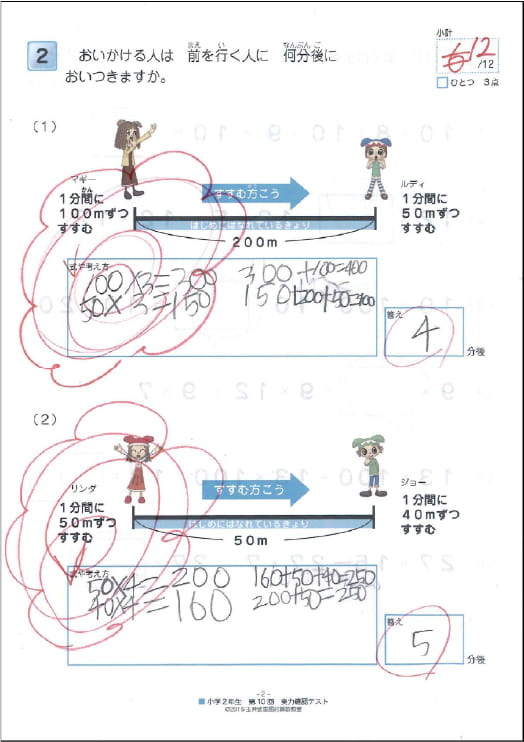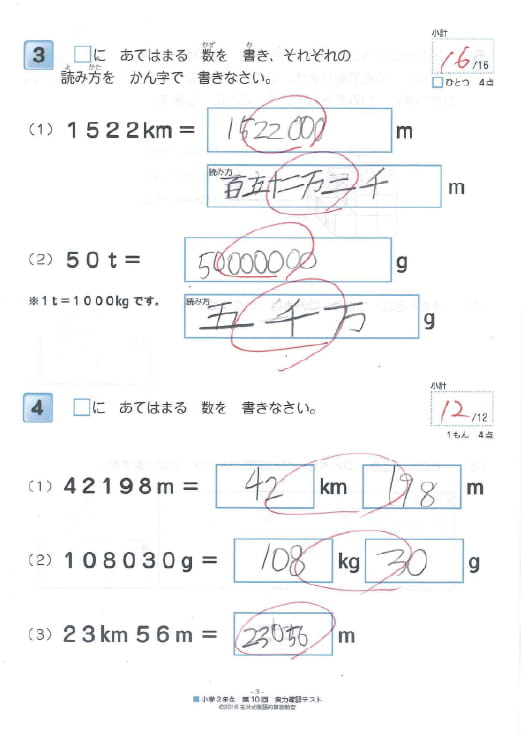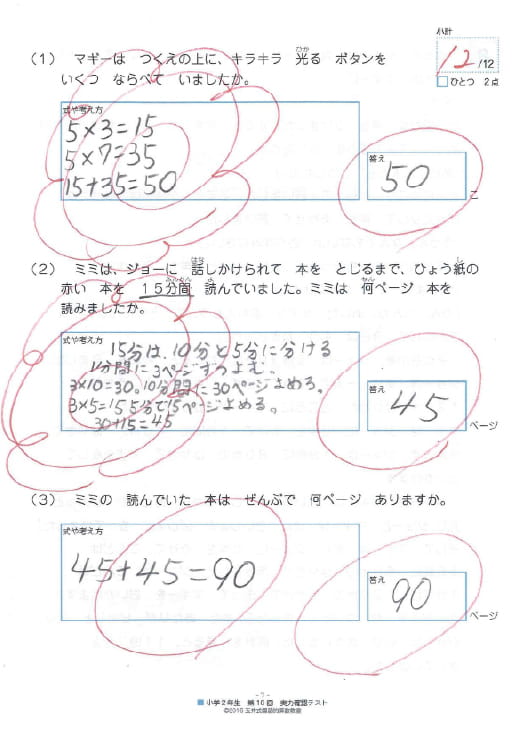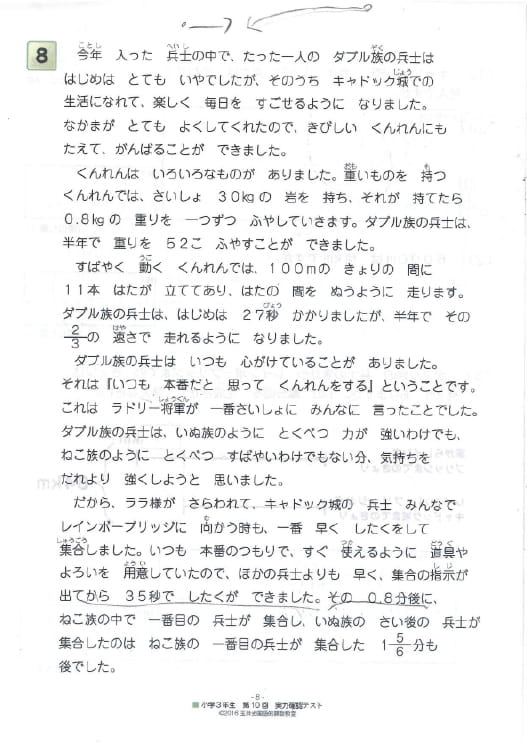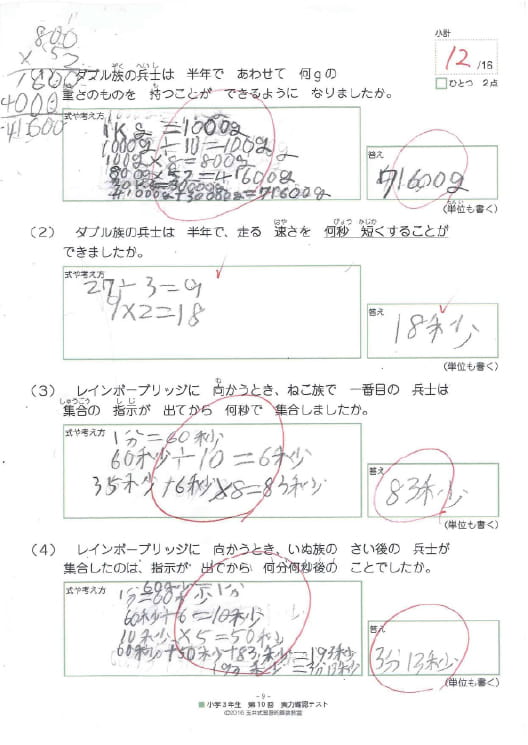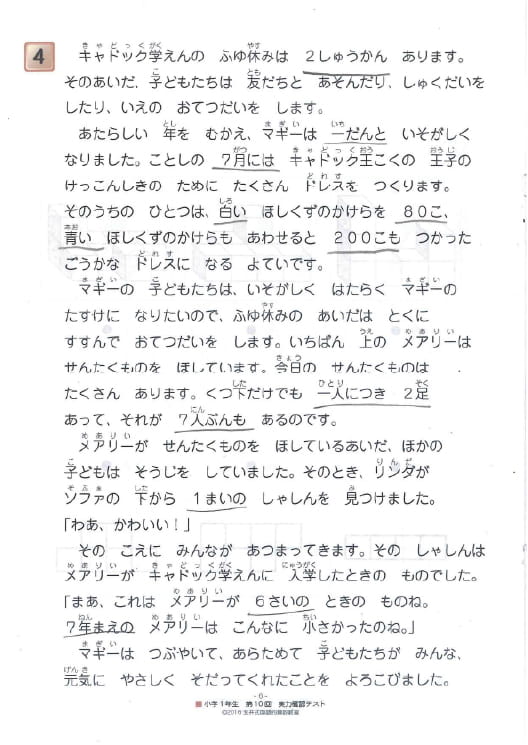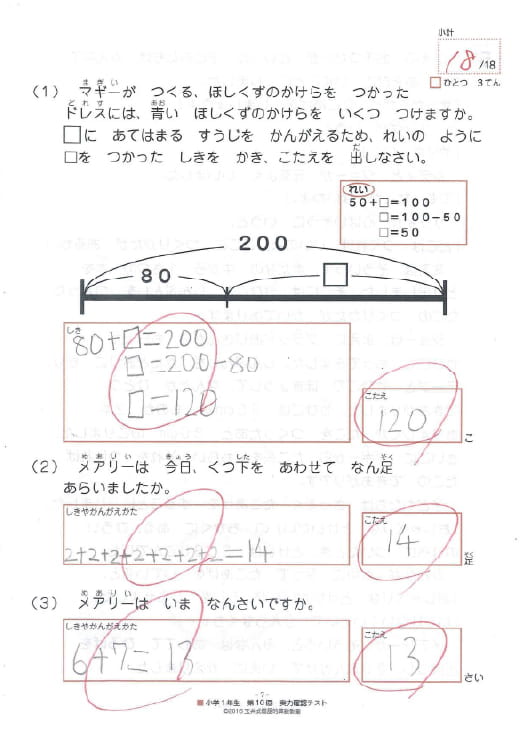The Tamaishiki for Developing
True Mathematical Thinking Skills

Tamaishiki M.R.C. (Mathematics with reading comprehension)
You don't even need to know the formula to come up with a solution!
A one-of-a-kind teaching method!
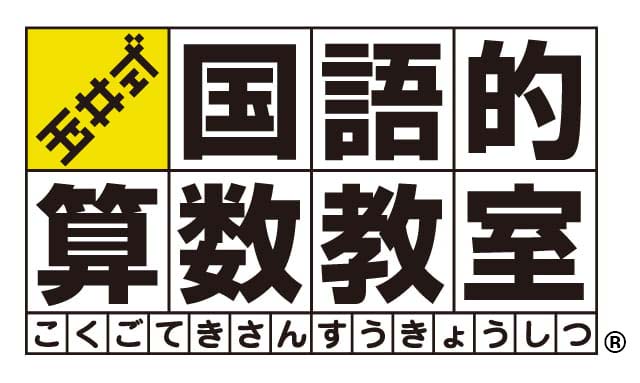
 Tamaishiki M.R.C.
Tamaishiki M.R.C.
This is What a 2nd Grader is Capable of!
An answer sheet from our student in
Tamaishiki M.R.C.
Usually students wouldn’t learn this problem until 5th grade at school. But after studying with Tamaishiki, this 2nd grader solved the problems without knowing any formulas!
Now you have an idea of how "quickly" you can learn using Tamaishiki.
If we use a formula to solve the problem (1) in [2],
we get (distance between them) / (difference in speed),
so 200 (m) / (100 (m)/min - 50 (m)/min) = 4 (min).
However, the number 4 doesn’t appear anywhere in this student’s formula. The student, who did not know the formula for speed, solved the problem with a "rough guess"
This student’s calculation process

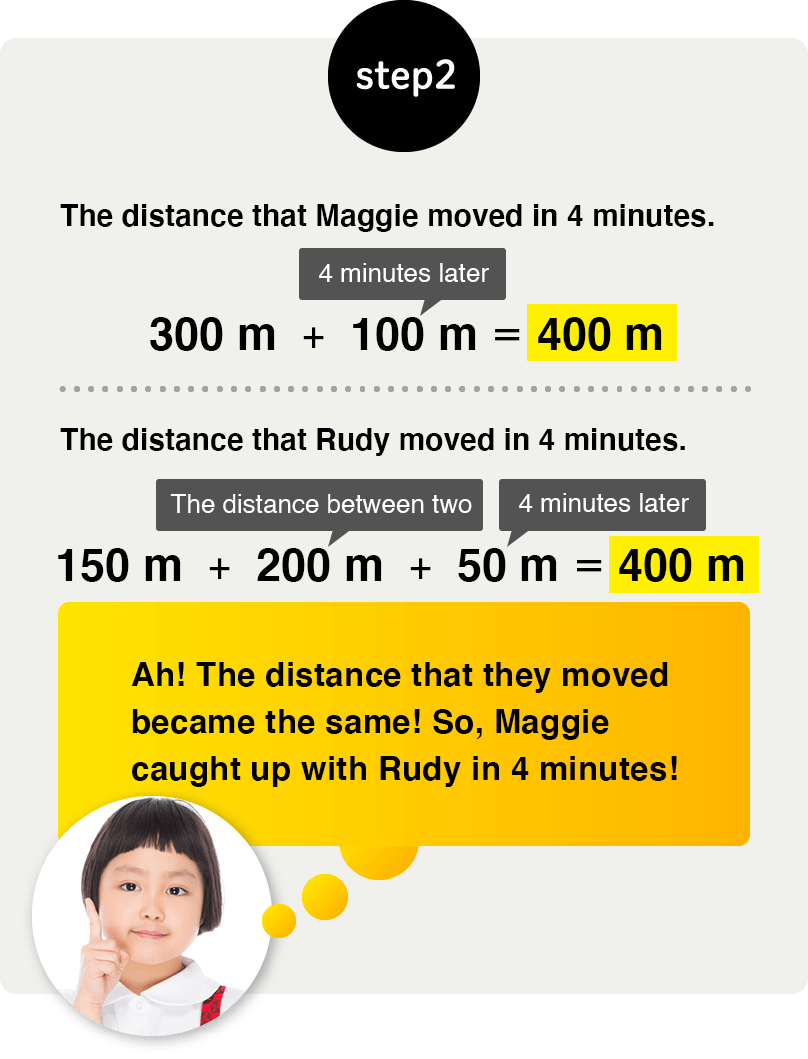
Students are able to solve the problem without the formula
because they have been trained to acquire the Japanese language (reading comprehension), creative minds, and mathematical thinking skills.
The sample answers at the Tamaishiki M.R.C. class
Acquired Thinking Skills
By thinking about the meaning and content of problems, students can understand "why things are the way they are" and create their own formulas (solutions).
"Tamaishiki M.R.C." is a learning style in which students think about the meaning and content of the problems before learning how to solve them with formulas. With formula-oriented study methods, if students happen to forget the formula, they won’t be able to solve the problem. With Tamaishiki, they develop their thinking ability so that they are able to create formulas and solutions without knowing the actual formula. Students think about how to solve the problem before learning formulas. Rather than focusing on finding answers quickly, students write a lot of diagrams and formulas themselves and gradually improve their thinking skills through trial and error.

Someone who memorizes formulas...

Someone who comes up with their own formulas...

The three strengths to become a student who can create formulas.
- Reading comprehension; to correctly understand the content of the question.
- Creative minds; to visualize the content that you understood in your mind.
- Mathematical thinking; to construct formulas
"Tamaishiki M.R.C." is a math teaching material developed so that students can acquire these three strengths naturally.

Four Features
that make it popular with children
While learning arithmetic, students naturally develop the strengths to read long sentences or solve difficult problems.

Learn to understand the "meaning" rather than "how to solve"!
A "spiral reading comprehension curriculum" that helps students think through problems thoroughly
Learning the formula first and then solving the problem is like reading a criminal mystery novel while knowing who the culprit is. We don't think about "Who could the culprit be?" nor the meaning of the problem. In Tamaishiki M.R.C., we make students think about the meaning of the problem first without teaching them the formula. They repeatedly study the curriculum that makes them think thoroughly about the problem and create their own formulas or diagrams through trial and error. Rather than just teaching formulas and instructions on how to solve problems, we encourage students to think about the problem deeply. By using this process, students build up their creative minds and mathematical thinking skills.
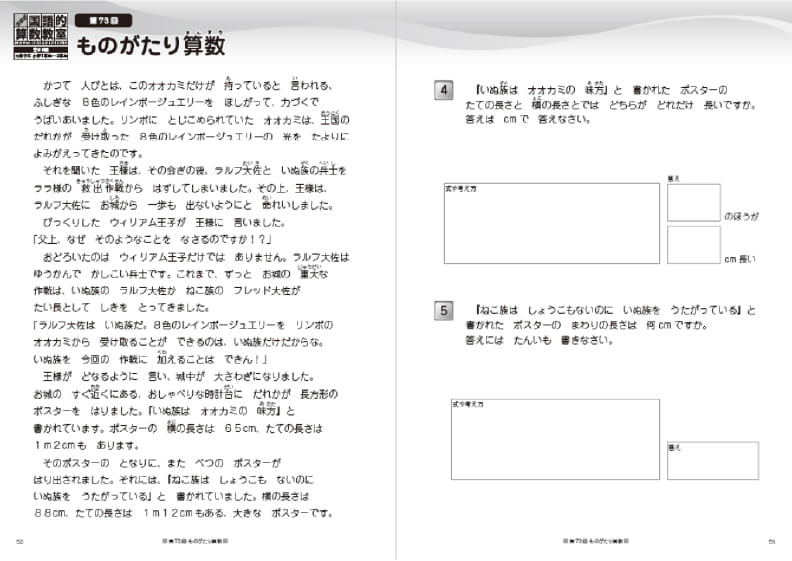

Teaching materials with the theme of "Family love" will help students develop both math and reading comprehension as the student realizes that "there are many ways to think about math in order to find the correct answers"
In Tamaishiki M.R.C., students will progress by watching animated stories to solve long word problems, while also working on the textbook. Our story is based on the children's book, "The Catdog Kingdom and a Wolf in Limbo", which contains fun characters and animations. It suites even young children to learn without losing their concentration. In addition, taking into account that young children learn through real objects, our math problems are introduced through the story, allowing the children to get a simulated experience while they think about the solution. This provides an opportunity for children to naturally learn how to think and answer math problems. Mitsuyo Tamai, a scriptwriter, and an educational advisor has an ideology that "Education materials with high-quality videos cultivate children's sensitivity." She includes a touch of family feeling in the materials that turn the textbook to be more enjoyable math learning material.
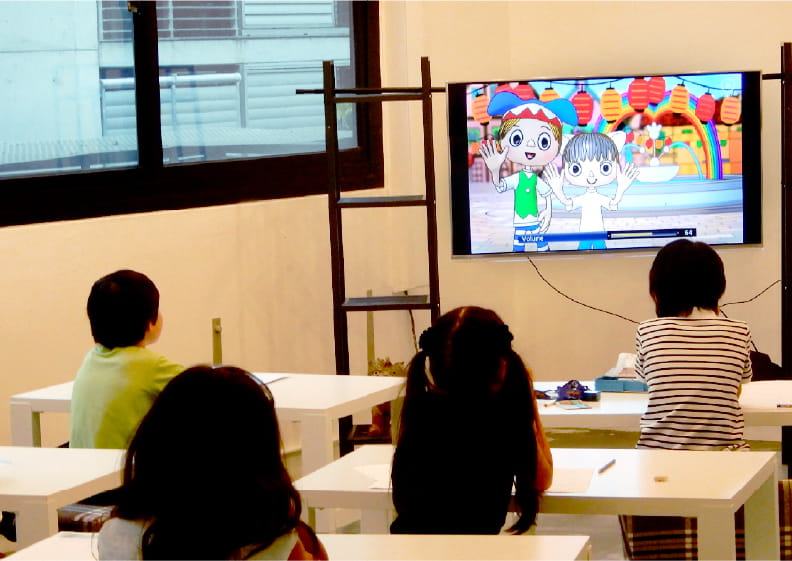

Students don't have to worry about long sentence reading comprehension and word problems anymore!
They will gain habits that will help them read any passage with no problem.
In Tamaishiki M.R.C., as one progresses through the lessons, the amount of visuals will gradually lessen, to gently ease the students into reading texts and solving problems on their own, building up a habit of reading texts without any struggle. For the long word problems, firstly students will be made to concentrate on listening to the audio, rather than reading the text. Second, students will follow the text with their eyes while listening to the audio, and finally, they will practice reading the text without listening to the audio. By using a step-by-step process, students will gradually lose their struggle to comprehend printed text and naturally develop the ability to read and understand (reading comprehension) on their own. Furthermore, since the end of the story is not presented visually but entirely in the text, the student will begin reading the long passage, to know the ending. This develops the habit of reading long passages for satisfaction. Even students who are not very good at reading will eventually be able to read comfortably. One of the features of Tamaishiki M.R.C. is to help students develop the habit of being able to read long passages by the time they reach the upper grades.
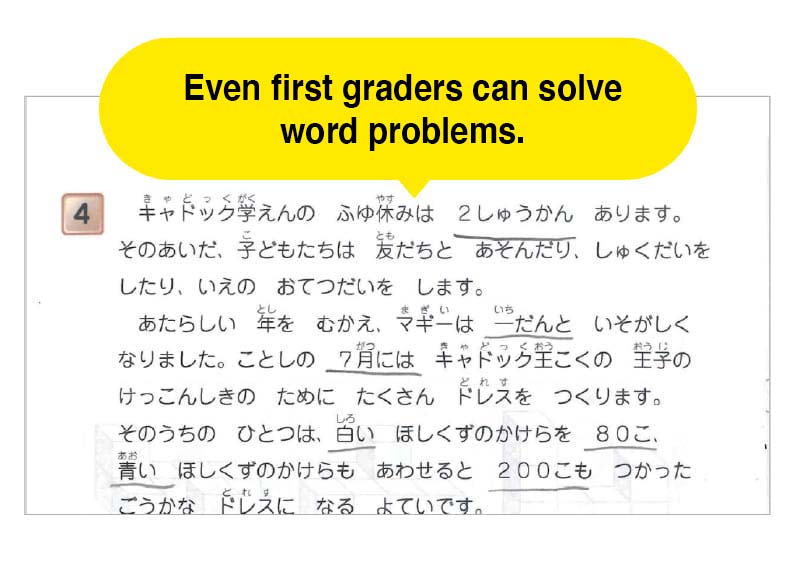
*Sample first grade word problems

"Discovering" rather than "being taught" how to solve a problem!
Drawing out children’s ability to think with the "Tamaishiki of Giving Hints"
When a child is stuck on a problem, clues will be provided in the video, so the child can self-discover the solution with them, rather than just simply giving out the answer. This is one of the strengths of Tamaishiki M.R.C. Through the nonchalantly given clues from our animation characters, the children will think and find the solution on their own. Being told the answer without having to think is the same as studying only to remember the formulas. This is why Tamaishiki also puts effort into how the clues are given to encourage children to think by themselves and develop their creative minds and mathematical thinking.
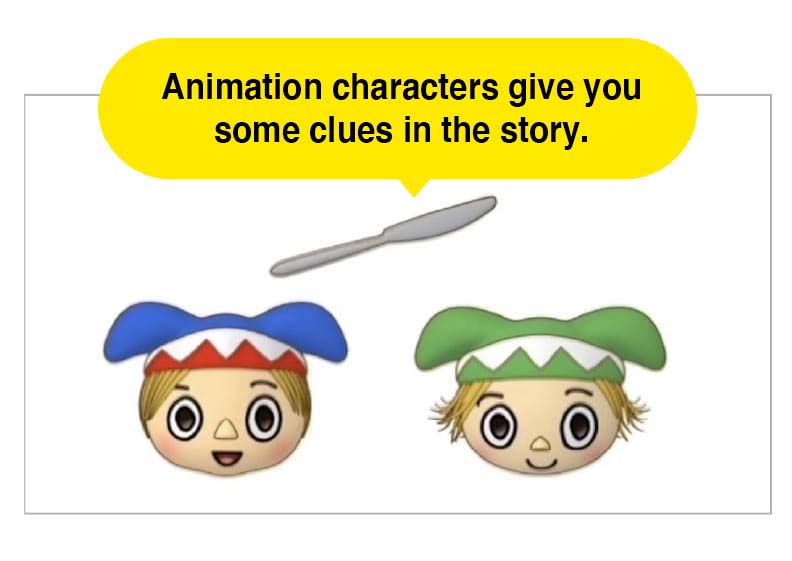
FAQ
About Tamaishiki M.R.C.
Can I watch the video on a device other than PC?
Yes. You can watch the video materials on a PC or tablet devices like iPad and smartphones. You can access them from home. See the System Requirements
By having animations, don't children feel like playing instead of studying?
When they are young, it is important to first make them feel that learning is fun. While Tamaishiki learning materials are designed to make learning enjoyble, it is actually a high quality curriculum. Animations can also help students visualize "why does this formula work" before they formally learn the actual formulas.
What should I teach at home as a parent? Is there anything parents should do?
The best thing to do is to wait. Wait for your child to express him/herself, rather than trying to teach it to him/herself. Another thing is to talk to him/her with the words and units that your child doesn't know on a daily basis, according to the situation. It helps to build his/her vocabulary and grammar.
What abilities will we gain from "Tamaishiki M.R.C."
When practicing just arithmetic problems, many children can calculate but have difficulty with word problems. That is why Tamaishiki aims for reading comprehension using long passages. Solving word problems means having strength to read and visualizing things from reading text. Tamaishiki provides the practices for building the strength. It will also give children the ability to come up with formulas on their own, avoiding the reliance on pattern learning.
How do I sign up for the course?
The Tamaishiki courses can be taken at home or online. Please apply from here. If you would like to take a face-to-face class, enroll in our in-person class. You can check it in " Serch for Tutoring Schools".


